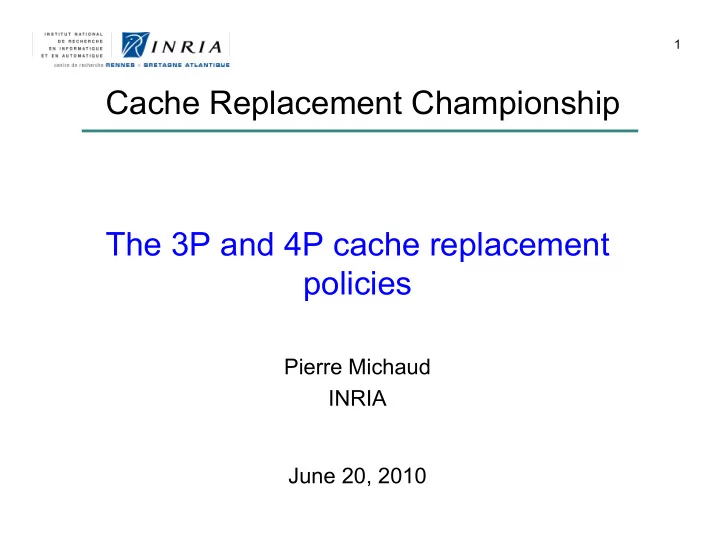

1 Cache Replacement Championship The 3P and 4P cache replacement policies Pierre Michaud INRIA June 20, 2010
2 Optimal replacement ? • Offline (we know the future) ➔ Belady • Online (we don’t know the future) ➔ problem without a solution – On random address sequences, all the online replacement policies perform equally on average The best online replacement policy does not exist
3 In practice… • We search a policy that performs well on as many applications as possible • We hope that our benchmarks are representative • But there is no guarantee that a replacement policy will always perform well
4 The DIP replacement policy • Qureshi et al., ISCA 2007 • Key idea #1: bimodal insertion (BIP) – LRU behaves badly on cyclic accesses ➔ try to correct this – On a miss, insert block in MRU position only with probability E=1/32, otherwise leave it in LRU position • Key idea #2: set sampling – 32 LRU sets, 32 BIP sets, use best policy in the other sets • Beauty of DIP: just one counter !
5 Proposed policy • Incrementally derived from DIP – Start from a carefully tuned DIP • Based on CLOCK instead of LRU – needs less storage than LRU • Combines more than 2 different insertion policies – (new ?) method for multi-policy selection
6 Carefully tuned DIP • Cache levels use unique line size ? ➔ OK – Otherwise a (small) filter would have been needed • Don’t update replacement info on writes – The fact that a block is evicted from a cache level does not mean that the block is likely to be accessed soon • If it is the case, it is chance, not a manifestation of temporal locality • 28 SPEC 2006, CRC simulator, 16-way 1M L3 • Speedup DIP / LRU ➔ avg: +2% ; max: +20% ; min: -4%
7 CLOCK DIP • CLOCK policy – one use bit per block, one clock hand per cache set • 16-way cache ➔ 16+4 = 20 bits per set – On access to a block (hit or insertion), set the use bit – On a miss, • hand points to potential victim • If use bit is set, reset it and increment the hand (mod 16), repeat till victim is found • CLOCK BIP – On insertion, set the use bit with probability E=1/32 • CLOCK DIP / DIP ➔ avg: +0.2% ; max: +1.2% ; min: -0.5%
8 Multi-policy selection mechanism • DIP uses a single PSEL counter – Miss in LRU-dedicated set ➔ decrement PSEL – Miss in BIP-dedicated set ➔ increment PSEL • Generalization: N policies, N counters P1,…,PN – Miss in set dedicated to policy j ➔ add N-1 to Pj, subtract 1 to all the other counters – Keep P1+P2+…+PN = 0 ➔ if a counter saturates, all counters stay unchanged – Best policy is the one with the smallest counter value
9 The 3P policy • For a few benchmarks, neither LRU nor BIP perform well – For example, 473.astar exhibits access patterns that are approximately cyclic, but drifting relatively quickly • We found that, on a few benchmarks, BIP with E=1/2 can outperform both LRU and BIP with E=1/32 ➔ 3 policies – All policies use the same hardware • For E=1/2, it is possible to improve MLP – Instead of setting the use bit every other insertions, set the use bit for 64 consecutive insertions every 128 misses • 3P / CLOCK DIP: avg: +0.5% ; max: +5.7% ; min: -2.1%
10 Shared-cache replacement • Thread-unaware policies like DIP or 3P may be unfair – OK when threads have equal force, i.e., equal miss rates (in misses per cycle) – But fragile threads (low miss rate) are penalized when they share the cache with aggressive threads (high miss rate) • BIP is good for containing aggressive threads • Thread-aware bimodal insertion (TABIP): use normal insertion for fragile threads and bimodal insertion for aggressive threads
11 TABIP: identifying fragile threads • Heuristic • One TMISS counter per running thread • Update TMISS counters the same way as policy-selection counters – E.g., 4 running threads – Thread k miss ➔ add 3 to TMISS [k], subtract 1 to TMISS of the other threads (keep sum of TMISS [i] null) • Define fragile threads as threads whose TMISS is negative
12 The 4P policy • 4P = 3P + CLOCK TABIP – Use 4 policy-selection counters instead of 3 • 28 SPEC 2006, CRC simulator, 16-way 4MB L3 • 100 fixed random 4-thread mixes ➔ perf for an app = arithmetic mean of CPIs for that app among the 400 CPIs • Speedup 4P / LRU: avg: +3% ; max: +18% ; min: -4.5% • Speedup 4P / 3P: avg: +1% ; max: +7% ; min: -3% • 4P is fairer than 3P
13 Questions ?
Recommend
More recommend